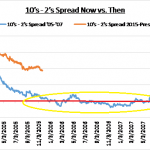Weekly Economic Cheat Sheet 12.28.15
Last Week
Data was sparse last week but the reports that did come were lack luster and while none of them are enough to increase concerns over the pace of the US economy, it is an undeniable point that data has underwhelmed lately, and that’s especially notable given the Fed just hiked rates.
The highlight last week was the Personal Income and Outlays Report (out last Wednesday), and the income and spending numbers largely met expectations, as did the really important metric in this report—Core PCE Price Index. The index rose 0.1% in November, meeting expectations while the year-over-year change remained unchanged at 1.3% (the same as October).
The Fed’s preferred measure of inflation once again didn’t follow November CPI higher, and between this and the durable goods number there was a slightly dovish takeaway from the data—although there’s so much time between now and the second hike (March at earliest, June most likely) that yesterday’s data won’t affect the decision in any way.
November Durable Goods was the next-most-important number last week, but it was by far the most disappointing. Headline durable goods were unchanged vs. (E ) -0.5%, but the beat was misleading. The flat monthly result was thanks to an uptick in defense spending, but the more important New Orders for “Non Defense Capital Goods Ex Aircraft” declined 0.4% in November, and the October gains were cut in half, from 1.3% to just 0.6%.
Business investment/spending was a bright spot in Q3, but it appears that is fading according to this latest report. This miss is another anecdotal negative in the manufacturing/capital goods segment of the economy. This likely will result in some small reduction of Q4 GDP estimates and reinforces the continued sluggishness in the broad manufacturing sector. This was not the number we would hope for following the first interest rate hike in nine years.
Finally, the November housing numbers continued to roll in last week and the results remain generally lackluster (meaning neither a headwind nor a tailwind on the broader economy).
The November Existing Home Sales number was a big miss vs. expectations (4.760M saar vs. (E) 5.320M saar) but the headline was misleading. In November the “Know Before You Owe” initiative began, which lengthens closing times for buyers. So, since Existing Home Sales are counted when the deal is closed, this caused an artificial delay that should be corrected in December.
Looking at some of the details, supply remains low at 2.04 million homes for sale vs. 2.11 million in October while prices remain firm (up 0.5% and 6.3% yoy). Price remains the key metric in this report, and overall it is healthy, so from an economic standpoint that’s mainly why these numbers aren’t a concern.
Bottom line, the details in the report imply the “real” Existing Home Sales number would have generally been “fine,” and while housing data lately has been a touch lackluster, the recovery remains firmly in place.
Again, bottom line, last week’s data wasn’t bad in an absolute sense and it certainly doesn’t imply the US economic recovery is losing momentum, but we would have liked to have seen better numbers given the Fed hiked rates two weeks ago. Again, data needs to turn better early in 2016, otherwise concerns about the pace of growth will start to rise.
This Week
This will be a very quiet week in the markets, given 1) The end of the year and 2) A very light economic calendar. There is virtually no foreign economic data throughout the week, and in the US there are only a few generally minor reports.
The most notable report will be the advanced Trade Balance out Tuesday, and that’s a bit more important than usual given the negative effect of the stronger US dollar on exports (and more broadly the manufacturing sector and corporate earnings). If exports are a big miss Tuesday morning that doesn’t bode well for manufacturing, so that’s why the market will care a bit more about this report than usual.
Looking past the trade balance there are two notable housing reports: Case-Shiller Home Price Index Tuesday and Pending Home Sales on Wednesday. As mentioned, price remains a critical factor in the housing market, so as long as Case-Shiller shows prices remain generally stable, then the outlook on housing won’t change. Pending Home Sales also remains important, but if it’s a “miss” for the right reasons—i.e., low supply—then that’s generally “ok” too, because the low supply will continue to support prices. Either way, unless one of these reports is a huge miss, the market should generally ignore them.
Bottom line, the advanced Trade Balance number is really the only potential wild card out there this week, and unless exports plunge it shouldn’t affect markets too much.
